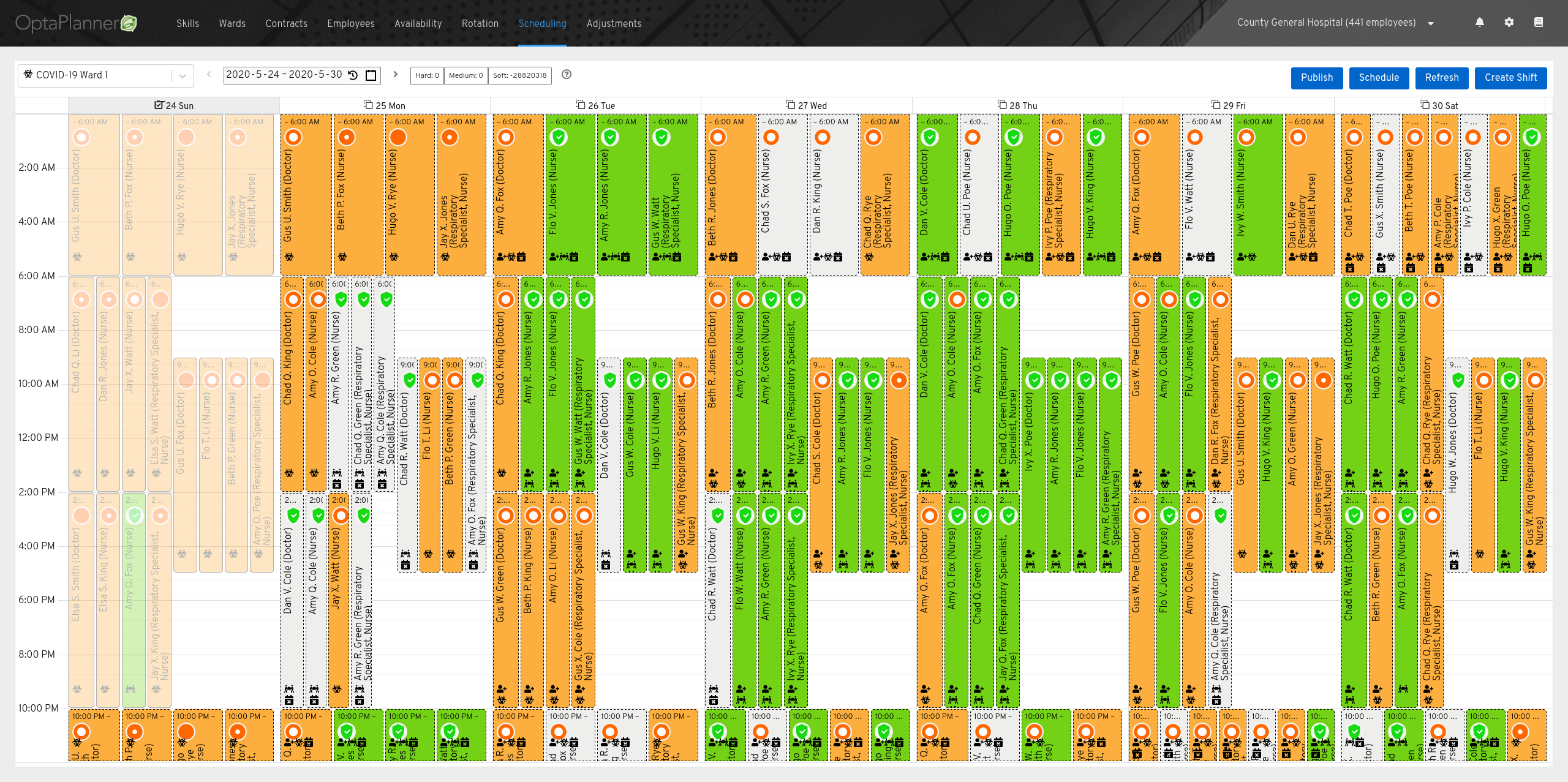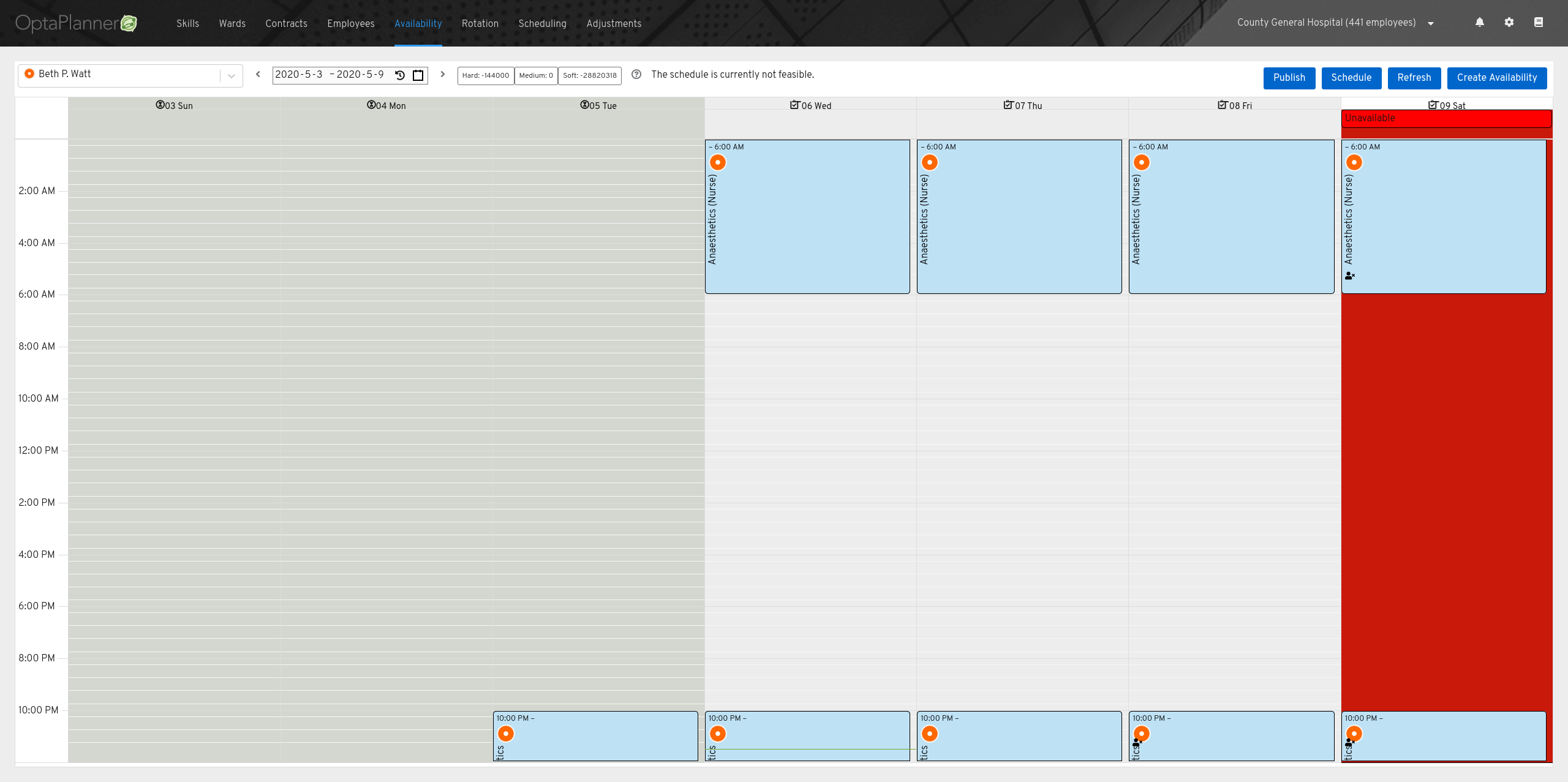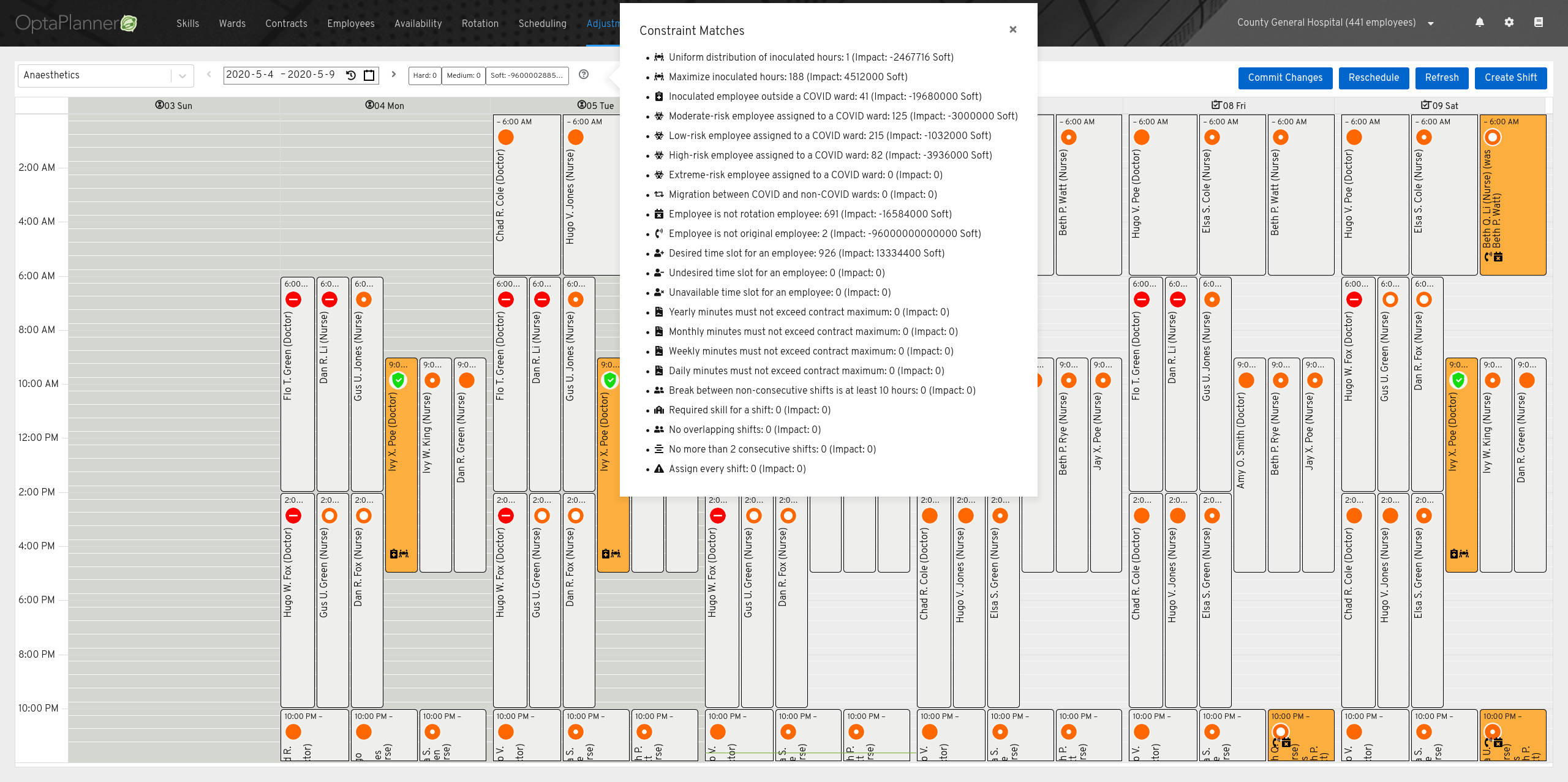AI versus COVID-19: How Java helps nurses and doctors in this fight
Scheduling a hospital is tough. To maintain employees’ happiness and health, you need to take into account sick days, days off requests, and assure the employees have ample time between shifts. This is doubly so in a pandemic, where you need to minimize exposure to the new disease and have nurses with varying susceptibilities to the disease. Let’s take a look at how we can quickly and efficiently schedule a hospital roster that minimizes cross-contamination between wards and maximizes employees’ happiness using OptaWeb Employee Rostering.
The domain
First, let’s set out the domain of our model:
-
There are wards, which are sections of the hospital, and are separated into COVID-19 wards and non-COVID-19 wards
-
There are employees, who are doctors and nurses who can be assigned to a ward, each having different susceptibilities to COVID-19 (for instance, some nurses are older and thus are more vulnerable)
-
There are skills, which describes what skill set an employee must have in order to work in a particular ward
-
There are shifts, which are positions that need to be filled at a given ward at a particular time, and may require additional skills in addition to those of its ward (for example, we need a repository specialist nurse in a COVID-19 ward, as well as a nurse and a doctor)
-
Finally, there are availabilities, which describes when an employee is unable to work, desires to work, or is requesting time off
The following class diagram shows the Java classes that represent this domain:

The constraints
OptaWeb Employee Rostering comes with a set of builtin constraints, which you can add to, modify or remove according to your needs. A few examples:
-
An employee cannot work two shifts that overlap; after all, how do you expect an employee to be in two places at the same time? As such, this is a hard constraint, meaning a schedule is infeasible if broken.
-
Whenever possible, an employee should not be working on a day they request off. Since the schedule remains feasible when an employee is working on a day they want off, this is a soft constraint.
-
The higher an employee’s COVID-19 susceptibility is, the less they should work in a COVID-19 ward. This is another soft constraint.
These, and the rest of the constraints, can be found in the Drools constraints file. They can also be implemented in Java using OptaPlanner’s Constraint Streams API.
Using the application
You can build and run OptaWeb Employee Rostering locally by cloning
its GitHub repository,
switching to the covid-19 branch, and following the instructions in the README.
OptaWeb Employee Rostering comes with both a backend and frontend. You could use the
bundled frontend or use the backend’s REST endpoints. The application by default
starts with demo data, allowing you to try out the application. Let’s use one of
example tenant and solve its roster. Navigate to the "Scheduling" tab and click
the (?) button next to the score. You will see a detailed summary of all the constraints.
On the bottom of the list, we see the constraint "Assign every shift" has 1116 matches, meaning we have
1116 unassigned shifts. Let’s fix that right now.

Close the summary popup and click on the "Schedule" button. OptaPlanner will begin solving the roster. After about 30 seconds, you’ll see there are no more unassigned shifts — that is, OptaPlanner assigned an employee to each of the 1116 shifts, all the while making sure no employee gets two shifts at the same time, each employee has the required skills for their shift, and each employee has enough rest between shifts. Imagine making a feasible schedule by assigning 1116 shifts by hand; it would take a good while longer than 30 seconds!

While solving, OptaPlanner will keep looking for better solutions, gradually improving the score. You might have already seen the schedule change several times already. Let’s stop solving for now. Click the Ward selector (left side of the toolbar) and change to the ward "COVID-19 Ward 1". Every shift has a small circle at the top of it denoting the COVID-19 susceptibility of its employee. A shield represents inoculated employees; people who have acquired immunity to COVID-19. A near-empty circle means the employee has a low COVID-19 susceptibility, while a more filled in circle means a higher COVID-19 susceptibility. Finally, a red circle means the employee is extremely susceptible to COVID-19, and should not be placed in a ward with COVID-19. Notice how there are no Extreme risk employees in the COVID-19 ward? Moreover, most of the COVID-19’s ward shifts either have inoculated or low-risk employees.

One second, I am getting a call. Okay, I’m back. Beth P. Watt caught the flu and as such is not able to make her shift this Saturday. Luckily for us, OptaPlanner can handle sudden changes well. Go to the "Availability" tab. Click the Employee selector (left side of the toolbar) and type in "Beth P. Watt". Click the Clock icon on the week selector to jump to the current week. Now click the area under the Saturday label on the calendar. This creates a new unavailability for the employee Beth P. Watt on Saturday.

You should now see a message indicating the schedule is not feasible in the toolbar. This is because Beth P. Watt is unavailable on Saturday but is assigned to a shift on Saturday. Let’s fix that. Navigate to the "Adjustments" tab, and click "Reschedule". You should notice OptaPlanner quickly fixed the schedule by assigning Beth P. Watt’s two shifts to another employee. Also, note that OptaPlanner changed only those two shifts; OptaPlanner will try to minimize the number of published shifts changed (after all, nurses and doctors have a life, which they plan around their schedules).

A few other things you can do with this application:
-
You can "pin" an employee to a particular shift, meaning OptaPlanner will not change that shift’s employee when solving.
-
You can create a rotation for the employees, giving them more consistency in their day-to-day lives and allowing automatic provisioning of new shifts.
Conclusion
As you just saw, OptaWeb Employee Rostering allows you to easily create and optimize rosters, that does not only minimize COVID-19’s effect on health care workers, but also maximizes their happiness. You can find the source code of this application at the OptaWeb Employee Rostering GitHub repository. This was only possible as OptaPlanner has such a flexible and easy way to add new constraints, allowing us to quickly modify OptaWeb Employee Rostering to accommodate the new constraints that came with COVID-19. You might also be interested in Geoffrey De Smet’s talk on the application.





Comments
Visit our forum to comment